Browse Primary Sources
Locate primary sources, including images, objects, media, and texts. Annotations by scholars contextualize sources.

Son of Saint–Louis Going Up to Heaven . . .
Many scholars would argue that Louis XVI’s finest moment came from his bravery at his execution. Even when he was forbidden from saying a last few words to those gathered to see him executed, he remained unflinching, retaining his composure. Here one can see the confessor, Edgeworth de Firmont, selected by Louis himself.
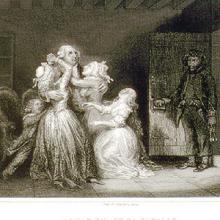
Louis XVI and His Family (20 January 1793)
Not shown in this or other scenes here is the fact that between the King’s two visits he ate a last meal. At this time he was denied, as was custom, a knife to avoid suicide. Louis was angered that his jailers thought he was so sinful as to take his own life.
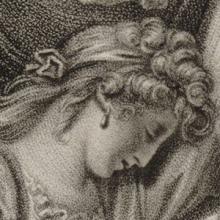
Last Meeting of Louis XVI with His Family at the Temple Prison
Another version of the final meeting of the King with his family. To the left is his confessor; the figure to the right is most likely Cléry, the King’s valet.

Louis Leaves His Family
What links the many scenes we have of the King and his family is the modern sensibility on display in all of them. Of course, since dates are uncertain, we must assume that several images hail from the nineteenth century. Yet all confirm the sentimentality that the twentieth century so embraces.
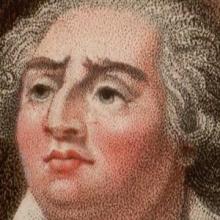
Louis’s Separation from His Family
After hearing the verdict, the King was allowed a final evening with his family, whom he had not seen for almost a month during the trial. Twice on the evening of 20 January the King met with his wife, his son, and a daughter. For about an hour and three–quarters all told, they visited. Only at this time, three days after the verdict, was the family told of the King’s sentence.
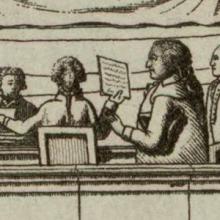
Image of the King on Trial
When he was charged, the King could have simply refused to participate on the grounds that the extant Constitution promised his immunity. But this defense, he knew, was useless and he elected to stand on his record. Among his attorneys was the distinguished and able old regime administrator Chrétlen–Guillaume de Malesherbes.
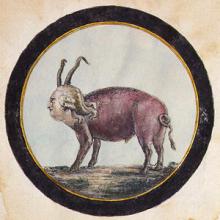
Louis as Pig
The Queen, never popular to begin with in France, also bore the brunt of popular anger in 1792, as seen in these images of the King, the Queen, and elsewhere the entire royal family, as animals.
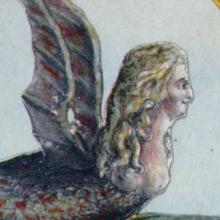
Marie Antoinette as a Serpent
The Queen, never popular to begin with in France, also bore the brunt of popular anger in 1792, as seen in these images of the King, Queen, and elsewhere the entire royal family, as animals.
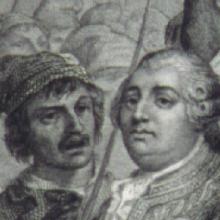
Image of the Attack of 20 June 1792
By the spring of 1792, the Revolution was in crisis on several fronts—in April, war had been declared on the Habsburg Empire, uprisings were taking place in provincial cities, and the Legislative Assembly was increasingly divided over whether to consolidate gains already made or press forward with more changes.

The King Accepting the Constitution amid the National Assembly, 14 September 1791
The Estates–General, reborn as the National Assembly, finished its work by completing a new constitution. This document provided for an executive—the King—as well as a legislative body. Suffrage was male and restricted to certain economic levels.

View of the Mound of Champ de la Reunion
In this watercolor of the Festival of the Supreme Being, we see a procession that includes a woman wearing a Phrygian cap paraded past a statue of Hercules holding two smaller statues of Liberty and Equality, towards a Liberty tree, atop the hill.
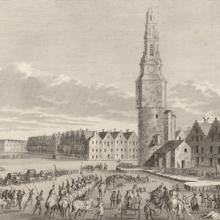
Entry of the French into Holland
From Berthault’s series of great moments of the Revolution, this engraving depicts the victorious entry of the republican French forces into the southern Netherlands (currently Belgium) on 21 January 1795, where a "sister republic" of Batavia would soon be established.
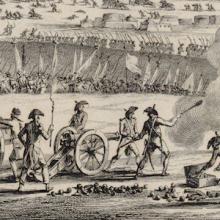
Battle of Aboukir
Napoleon’s eventual acquisition of political power may be attributed partly to his success in publicizing his Egyptian campaign as a great victory for France that spread the values of the Revolution. These engravings by the writer and artist Vivant Denon were published in 1802, four years after the campaign when Napoleon was already in power.
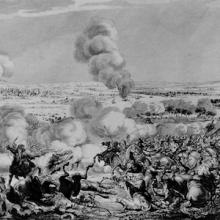
Battle of the Pyramids
After a six–week journey from France, the army of some 38,000 arrived in Egypt. The French stormed and took Alexandria first, then moved up the Nile toward Cairo. On 21 July Napoleon’s troops confronted and decisively defeated the army of the Mamelukes, who exercised rule in Egypt on behalf of the Ottomans.
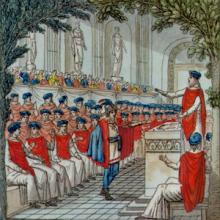
Costumes of the Council of Five Hundred
In this bicameral legislature, the smaller of the two councils (the Elders with 250 members) had to pass all the legislation, while the Five Hundred could initiate legislation. The revolutionaries decided on the division of authority. The directors functioned as the executive branch, in order to make less possible the consolidation of power, as in the Terror.
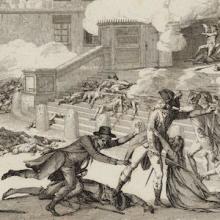
Day of 13 Vendemaire of the Year 4
In the waning days of the Convention in the fall of 1795, royalist–influenced sections of Paris revolted to prevent the adoption of a new constitution that protected the position of the radicals. Bonaparte was delegated to put down the uprising of 5 October 1795 (13 Vendémiaire Year IV).
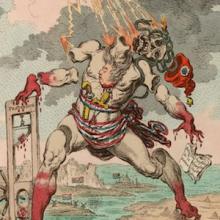
Destruction of the French Colossus
This hand–colored engraving, published in late 1798, depicts a Hercules representing France being decapitated by a lighting bolt in divine retribution for the executions by guillotine and for the attempt to create "Fraternity" and a "Religion of Nature" to replace the Christian love of God. Notice that it is the British who launch these deadly attacks.
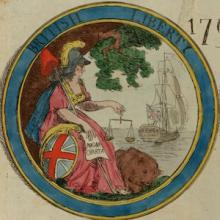
The Contrast, 1793 British Liberty/French Liberty
In this color print from 1793, the height of the Terror, two circular drawings appear next to each other, contrasting two types of liberty. English liberty exists, as the figure suggests, but based on the Magna Carta, calm prevails. Representing French liberty is an uncontrolled, unruly woman, a killer and destroyer.
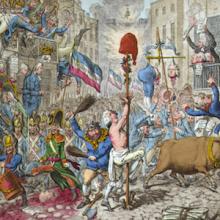
Promised Horrors of the French Invasion
This highly sophisticated political cartoon by the noted engraver James Gillray from October 1796 responds to Edmund Burke’s pamphlet, "Reflections on a Regicide Peace." This image argues against further war with France to avoid bankrupting the British treasury and exposing England itself to invasion.
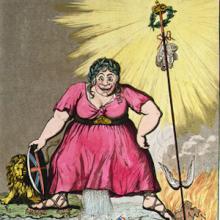
Britannia Rules the Waves!!
This color drawing from 1798 mocks both the French navy’s abysmal performance against Nelson’s fleet and the French hope to invade England; in the style of Gillray, it depicts a grotesque, gargantuan woman, straddling the English Channel and urinating into French ships while her trident pierces France and breaks off pieces to be seized by Britain.